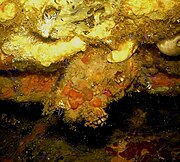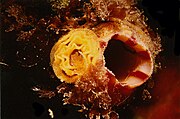Microcosmus sabatieri
| Microcosmus sabatieri | |
|---|---|

| |
| Microcosmus sabatieri | |
| Scientific classification | |
| Domain: | Eukaryota |
| Kingdom: | Animalia |
| Phylum: | Chordata |
| Subphylum: | Tunicata |
| Class: | Ascidiacea |
| Order: | Stolidobranchia |
| Family: | Pyuridae |
| Genus: | Microcosmus |
| Species: | M. sabatieri |
| Binomial name | |
| Microcosmus sabatieri (Roule, 1885) | |
| Synonyms[1] | |
| |
Microcosmus sabatieri, commonly called the grooved sea squirt,[2] sea fig,[3] or violet,[3] is a species of tunicates (sea squirts). The species has a rocky-shape appearance. It is mainly found in the Mediterranean Sea.[4] It is used as food in parts of Europe.[2]
Uses
Three species of Microcosmus are edible presently, M. sabatieri, M. vulgaris, and M. polymorphus (Vafidis 2008). [citation needed] In the Mediterranean Basin, it is eaten raw, often with an acidic condiment such as lemon juice or vinegar with shallots.[citation needed] It has a strong iodine taste which not all appreciate.[citation needed]
Names
The specific epithet sabatieri is in honor of zoologist Armand Sabatier.[3] The name 'violet' is from the distinguishing violet stripes on the siphon.[3]
The species has many common names. In Dutch it is violet-zakpijp (lit. violet pocket-pipe)[2] or begroeide zakpijp (overgrown pocket-pipe).[3] In French it's violet,[2][3] figue de mer (lit. sea fig),[3] and in Marseille, patate de mer (lit. sea potato),[3] or vioulé.[3] In Northern Catalonia it's called biju or bijut (jewel)[3] and in the Principality bunyol or ou de mar (sea fritter or sea egg).[5] In German the common term is Seefeige (lit. sea fig)[2] or eßbare Seescheide (edible sea sheath).[3] It is Φούσκα (foúska, lit. bubble or puff) in Greek.[4] In Italian, limone di mare (sea lemon) or uova di mare (sea egg) are used.[3] Names in Spanish include provecho (profit), patatas de mar (sea potatoes), and buñuelo de mar (sea fritter).[3] In Ligurian it can be called stronsci de mä (sea turds).[3] In Morocco, in both Moroccan Darija and Berber, it's called fezḍāḍ (فزضاض) or afezḍāḍ (ⴰⴼⴻⵣⴹⴰⴹ, أفزضاض).[6]
Other names it is sold under include:
- viourlet[citation needed]
- bijut/bichu[citation needed]
- carnummole (Campania)[citation needed]
- morsko jaje (lit. "sea egg"; Croatia)[citation needed]
- taratufi (Apulia)[citation needed]
Note that plants of the genus Carpobrotus are also known as 'sea figs'.[7]
Gallery
- Microcosmus sabatieri at Banyuls-sur-Mer
- Microcosmus sabatieri at Banyuls-sur-Mer
- Inhalant siphon of Microcosmos sabatieri. The yellow feature at the left is a clutch of mollusk eggs.
References
- ^ Shenkar, N.; Gittenberger, A.; Lambert, G.; Rius, M.; Moreira Da Rocha, R.; Swalla, B.J.; Turon, X. (2018). Ascidiacea World Database. Microcosmus sabatieri Roule, 1885. Accessed through: World Register of Marine Species at: http://www.marinespecies.org/aphia.php?p=taxdetails&id=103844 on 2018-02-13
- ^ a b c d e Beleidsinformerende Nota: Wetenschappelijke en handelsbenamingen voor visserij- en aquacultuurproducten op de Belgische markt (PDF) (in Dutch). Oostende: Vlaams Instituut voor de Zee. 12 October 2016. ISBN 978-94-92043-42-9. ISSN 2295-7464. Retrieved 13 February 2018.
Microcosmus sabatieri violet-zakpijp violet Seefeige grooved sea squirt
- ^ a b c d e f g h i j k l m n Ader, Denis; André, Frédéric; Huet, Sylvie (7 August 2016). "Microcosmus sabatieri". Données d'Observations pour la Reconnaissance et l'Identification de la faune et la flore Subaquatiques (in French). Retrieved 13 February 2018.
- ^ a b Sanamyan, Karen; de Jong, Y. (5 December 2007). "Microcosmus sabatieri Roule, 1885". Pan-European Species directories Infrastructure. Retrieved 13 February 2018.
Vernaculars (-) Greek: Φούσκα
- ^ "Gran Diccionari de la llengua catalana".
- ^ Mohamed Chafik (1999). الدارجة المغربية، مجال توارد بين الأمازيغية و العربية (in Arabic). p. 51.
- ^ "Sea figs Genus Carpobrotus". iNaturalist. San Francisco. Retrieved 13 February 2018.



